Bottom-Up Estimates of the Cost of Supplying High-Temperature Industrial Process Heat from Intermittent Renewable Electricity and Thermal Energy Storage in Australia
Abstract
:1. Introduction
2. Methodology
2.1. Defining the Heat Demand
2.2. Defining the Solar and Wind “Base” Systems
2.3. Capacity Factor for the Solar and Wind Installations
2.4. Storage Technology and Model
2.5. System Model and Storage Sizing
2.6. Economic Analysis
3. Results
3.1. Minimum Storage Capacity for Each Target Renewable Energy Share
3.2. Economic Analysis
3.2.1. Analysis of the Capital Cost
3.2.2. Analysis of the Upper Bound of the LCOEU
3.2.3. Analysis of the Lower Bound for the LCOEL
3.2.4. Comparison to the Natural Gas Cost in Australia and Hydrogen Production Target Price
4. Conclusions
Author Contributions
Funding
Institutional Review Board Statement
Informed Consent Statement
Data Availability Statement
Conflicts of Interest
References
- Climate Change 2022: Impacts, Adaptation and Vulnerability. Available online: https://www.ipcc.ch/report/ar6/wg2/ (accessed on 19 April 2022).
- Lovegrove, K.; Alexander, D.; Bader, R.; Edwards, S.; Lord, M.; Mojiri, A.; Rutovitz, J.; Saddler, H.; Stanley, C.; Urkalan, K.; et al. Renewable Energy Options for Industrial Process Heat; Australian Renewable Energy Agency (ARENA): Turner, Australia, 2019. [Google Scholar]
- Cozzi, L.; Gould, T. World Energy Outlook 2019; International Energy Agency: Paris, France, 2019. [Google Scholar]
- Kempener, R.; Saygin, D. Renewable Energy in Manufacturing: A Technology Roadmap for REmap 2030; International Renewable Energy Agency (Irena): Abu Dhabi, United Arab Emirates, 2014. [Google Scholar]
- Wei, M.; McMillan, C.A.; de la Rue du Can, S. Electrification of Industry: Potential, Challenges and Outlook. Curr. Sustain. Renew. Energy Rep. 2019, 6, 140–148. [Google Scholar] [CrossRef]
- Renewable Energy Options for the Industry Sector: Global and Regional Potential Until 2030—Background to “Renewable Energy in Manufacturing” Technology Roadmap (IRENA, 2014a); Background Paper; Irena: Abu Dhabi, United Arab Emirates, 2015.
- Global Energy Transformation: A Roadmap to 2050, 2019th ed.; Irena International Renewable Energy Agency: Abu Dhabi, United Arab Emirates, 2019; p. 52.
- Bogdanov, D.; Breyer, C. North-East Asian Super Grid for 100% Renewable Energy Supply: Optimal Mix of Energy Technologies for Electricity, Gas and Heat Supply Options. Energy Convers. Manag. 2016, 112, 176–190. [Google Scholar] [CrossRef]
- Blakers, A.; Lu, B.; Stocks, M. 100% Renewable Electricity in Australia. Energy 2017, 133, 471–482. [Google Scholar] [CrossRef]
- Garnout, R. Superpower: Australia’s Low-Carbon Opportunity; Schwartz Publishing Pty, Limited: Melbourne, Australia, 2019; ISBN 978-1-76064-174-0. [Google Scholar]
- Strasser, M.N.; Selvam, R.P. A Cost and Performance Comparison of Packed Bed and Structured Thermocline Thermal Energy Storage Systems. Sol. Energy 2014, 108, 390–402. [Google Scholar] [CrossRef] [Green Version]
- Storage and Hybridization of Nuclear Energy—1st Edition. Available online: https://www.elsevier.com/books/storage-and-hybridization-of-nuclear-energy/bindra/978-0-12-813975-2 (accessed on 19 April 2022).
- Williams, F.; Schmidt, H.-W. Flash- and CFB Calciners, history and difficulties of development of two calcination technologies. In Light Metals 2012; Suarez, C.E., Ed.; John Wiley & Sons, Inc.: Hoboken, NJ, USA, 2012; pp. 135–140. ISBN 978-1-118-35925-9. [Google Scholar]
- Global Renewables Outlook: Energy Transformation 2050; Irena: Abu Dhabi, United Arab Emirates, 2020.
- Jenkins, B.; Bertrand, C. Improvements in the Design and Operation of Alumina Flash Calciners. IFRF Combust. J. 2001, 10, 2–18. [Google Scholar]
- Projected Costs of Generating Electricity 2020–Analysis. Available online: https://www.iea.org/reports/projected-costs-of-generating-electricity-2020 (accessed on 20 April 2022).
- German Aerospace Center (DLR); Institute for Solar Research of the DLR. Greenius—The Green Energy System Analysis Tool. Available online: https://www.dlr.de/sf/en/desktopdefault.aspx/tabid-11688/20442_read-44865/ (accessed on 20 April 2022).
- Vela Solaris, A.G. Polysun Simulation Software; Vela Solaris AG: Winterthur, Switzerland, 2020. [Google Scholar]
- Global Solar Atlas Data Obtained from the Global Solar Atlas 2.0, a Free, Web-Based Application Is Developed and Operated by the Company Solargis s.r.o. on Behalf of the World Bank Group, Utilizing Solargis Data, with Funding Provided by the Energy Sector Management Assistance Program (ESMAP). Available online: https://globalsolaratlas.info (accessed on 20 April 2022).
- Global Wind Atlas Data Obtained from Global Wind Atlas 3.0, a Free, Web-Based Application Developed, Owned and Operated by the Technical University of Denmark (DTU). The Global Wind Atlas 3.0 Is Released in Partnership with the World Bank Group, Utilizing Data Provided by Vortex, Using Funding Provided by the Energy Sector Management Assistance Program (ESMAP). Available online: https://globalwindatlas.info (accessed on 20 April 2022).
- European Commision Joint Resaerch Centre PVGIS 5.2. Available online: https://joint-research-centre.ec.europa.eu/pvgis-photovoltaic-geographical-information-system/pvgis-releases/pvgis-52_en (accessed on 17 May 2022).
- Australia–Asia Wind Energy Association. Available online: https://www.asiawind.org/research-data/market-overview/australia/ (accessed on 22 April 2022).
- Renewable Energy Capacity Factor Maps. 2021. Available online: https://ecat.ga.gov.au/geonetwork/srv/api/records/0b2f1c73-0358-4ff0-9572-2d1ab5077566 (accessed on 22 April 2022).
- Zunft, S.; Hänel, M.; Krüger, M.; Dreißigacker, V.; Göhring, F.; Wahl, E. Jülich Solar Power Tower—Experimental Evaluation of the Storage Subsystem and Performance Calculation. J. Sol. Energy Eng. 2011, 133, 031019. [Google Scholar] [CrossRef]
- Sardeshpande, V.; Anthony, R.; Gaitonde, U.N.; Banerjee, R. Performance Analysis for Glass Furnace Regenerator. Appl. Energy 2011, 88, 4451–4458. [Google Scholar] [CrossRef]
- Hänchen, M.; Brückner, S.; Steinfeld, A. High-Temperature Thermal Storage Using a Packed Bed of Rocks–Heat Transfer Analysis and Experimental Validation. Appl. Therm. Eng. 2011, 31, 1798–1806. [Google Scholar] [CrossRef]
- Toman, M.; Cipin, R.; Cervinka, D.; Vorel, P.; Prochazka, P. Li-Ion Battery Charging Efficiency. ECS Trans. 2016, 74, 37. [Google Scholar] [CrossRef]
- Weitemeyer, S.; Kleinhans, D.; Vogt, T.; Agert, C. Integration of Renewable Energy Sources in Future Power Systems: The Role of Storage. Renew. Energy 2015, 75, 14–20. [Google Scholar] [CrossRef] [Green Version]
- Prina, M.G.; Weitemeyer, S.; Vaccaro, R.; Manzolini, G.; Kleinhans, D.; Garegnani, G.; Moser, D. Large-Scale Integration of Renewable Energy Sources: Technical and Economical Analysis for the Italian Case. In Proceedings of the 32nd European Photovoltaic Solar Energy Conference and Exhibition, WIP, Munich, Germany, 25 July 2016; pp. 2670–2674. [Google Scholar] [CrossRef]
- Kueh, K.C.Y.; Nathan, G.J.; Saw, W.L. Storage Capacities Required for a Solar Thermal Plant to Avoid Unscheduled Reductions in Output. Sol. Energy 2015, 118, 209–221. [Google Scholar] [CrossRef]
- National Renewable Energy Laboratory; Sandia National Laboratory; SunSpec Alliance, and the SunShot National Laboratory Multiyear Partnership; (SuNLaMP) PV O&M Best Practices Working Group. Best Practices for Operation and Maintenance of Photovoltaic and Energy Storage Systems; NREL/TP-7A40-73822; National Renewable Energy Laboratory: Golden, CO, USA, 2018. [Google Scholar]
- Stehly, T.; Beiter, P.; Duffy, P. 2019 Cost of Wind Energy Review. Renew. Energy 2020, 86, 1756710. [Google Scholar]
- Onshore Wind Power Installation Costs 2020. Available online: https://www-statista-com.libproxy.unibz.it/statistics/506774/weighted-average-installed-cost-for-onshore-wind-power-worldwide/ (accessed on 21 April 2022).
- US Wind O&M Costs Estimated at $48,000/MW; Falling Costs Create New Industrial Uses: IEA | Reuters Events | Renewables. Available online: https://www.reutersevents.com/renewables/wind-energy-update/us-wind-om-costs-estimated-48000mw-falling-costs-create-new-industrial-uses-iea (accessed on 21 April 2022).
- Vartiainen, E.; Masson, G.; Breyer, C.; Moser, D.; Román Medina, E. Impact of Weighted Average Cost of Capital, Capital Expenditure, and Other Parameters on Future Utility-Scale PV Levelised Cost of Electricity. Prog. Photovolt. Res. Appl. 2020, 28, 439–453. [Google Scholar] [CrossRef] [Green Version]
- Solar PV Installation Cost Globally 2020. Available online: https://www.statista.com/statistics/809796/global-solar-power-installation-cost-per-kilowatt/ (accessed on 21 April 2022).
- Walker, H.; Lockhart, E.; Desai, J.; Ardani, K.; Klise, G.; Lavrova, O.; Tansy, T.; Deot, J.; Fox, B.; Pochiraju, A. Model of Operation-and-Maintenance Costs for Photovoltaic Systems; National Renewable Energy Lab. (NREL): Golden, CO, USA, 2020. [Google Scholar]
- Brinsmead, T.; Graham, P.; Hayward, J.; Ratnam, E.; Reedman, L. Future Energy Storage Trends: An Assessment of the Economic Viability, Potential Uptake and Impacts of Electrical Energy Storage on the NEM 2015–2035; CSIRO: Canberra, Australia, 2015. [Google Scholar]
- Sens, L.; Neuling, U.; Kaltschmitt, M. Capital Expenditure and Levelized Cost of Electricity of Photovoltaic Plants and Wind Turbines–Development by 2050. Renew. Energy 2022, 185, 525–537. [Google Scholar] [CrossRef]
- Gas Market Prices. Available online: https://www.aer.gov.au/wholesale-markets/wholesale-statistics/gas-market-prices (accessed on 22 April 2022).
- Hydrogen Production. Available online: https://www.energy.gov/eere/fuelcells/hydrogen-production (accessed on 27 April 2022).
- Renewable Power Generation Costs in 2020. Available online: https://www.irena.org/publications/2021/Jun/Renewable-Power-Costs-in-2020 (accessed on 22 April 2022).
- López Prol, J.; Steininger, K.W.; Zilberman, D. The Cannibalization Effect of Wind and Solar in the California Wholesale Electricity Market. Energy Econ. 2020, 85, 104552. [Google Scholar] [CrossRef]

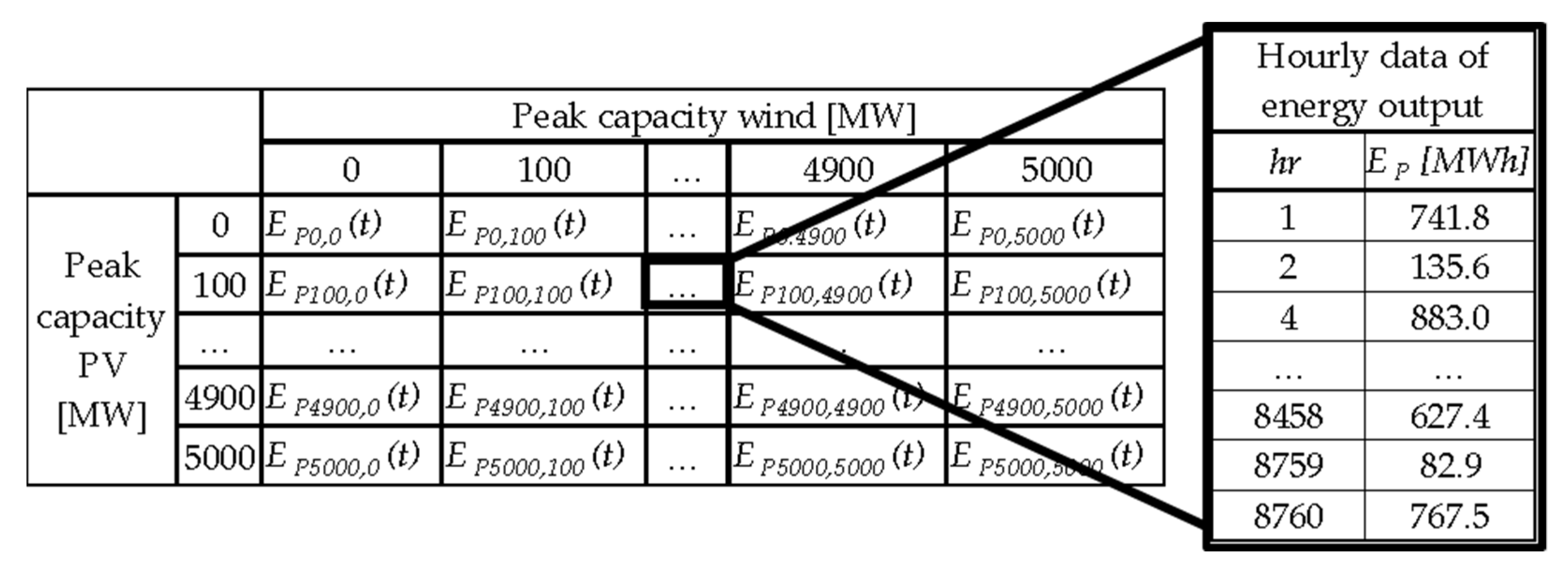
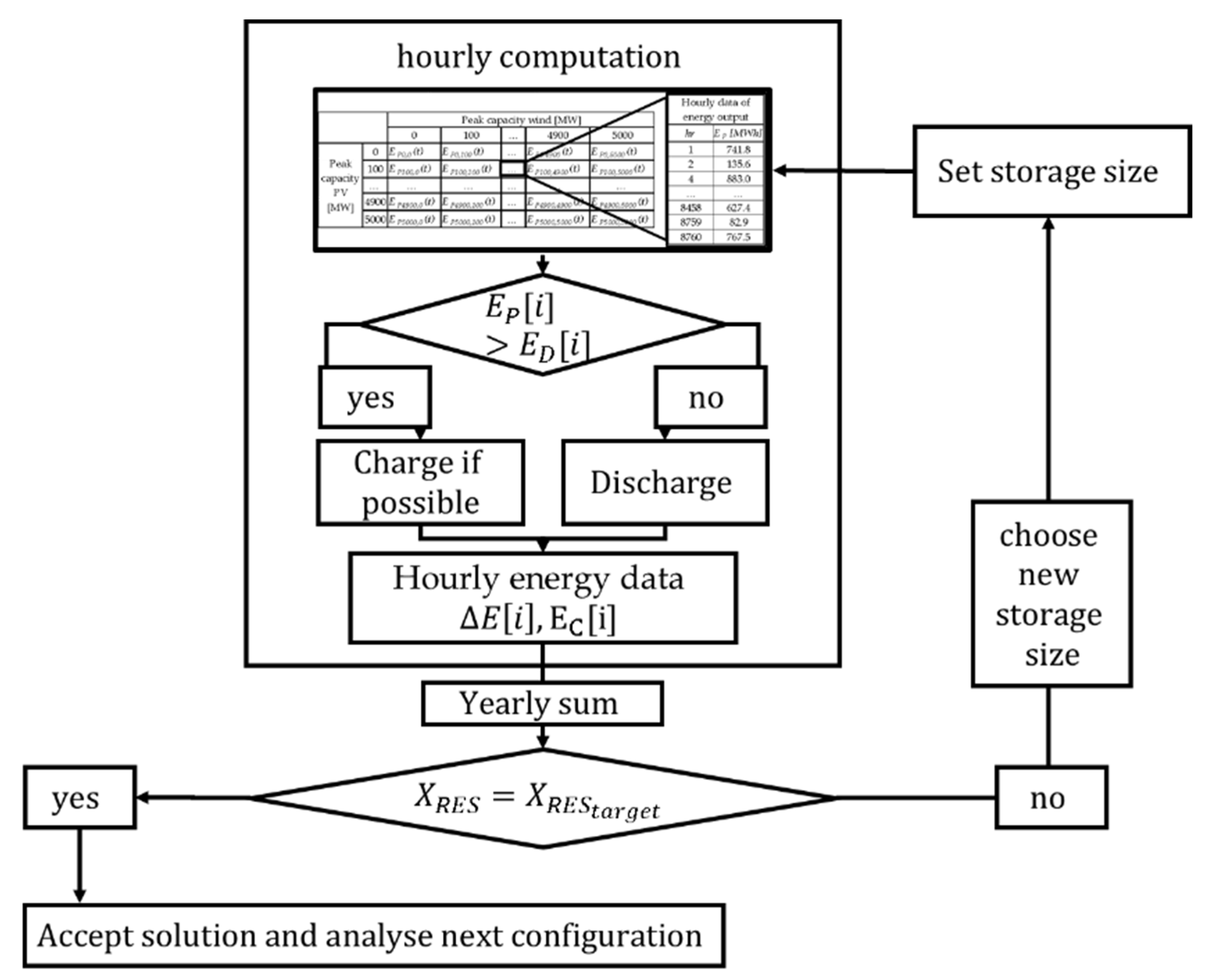

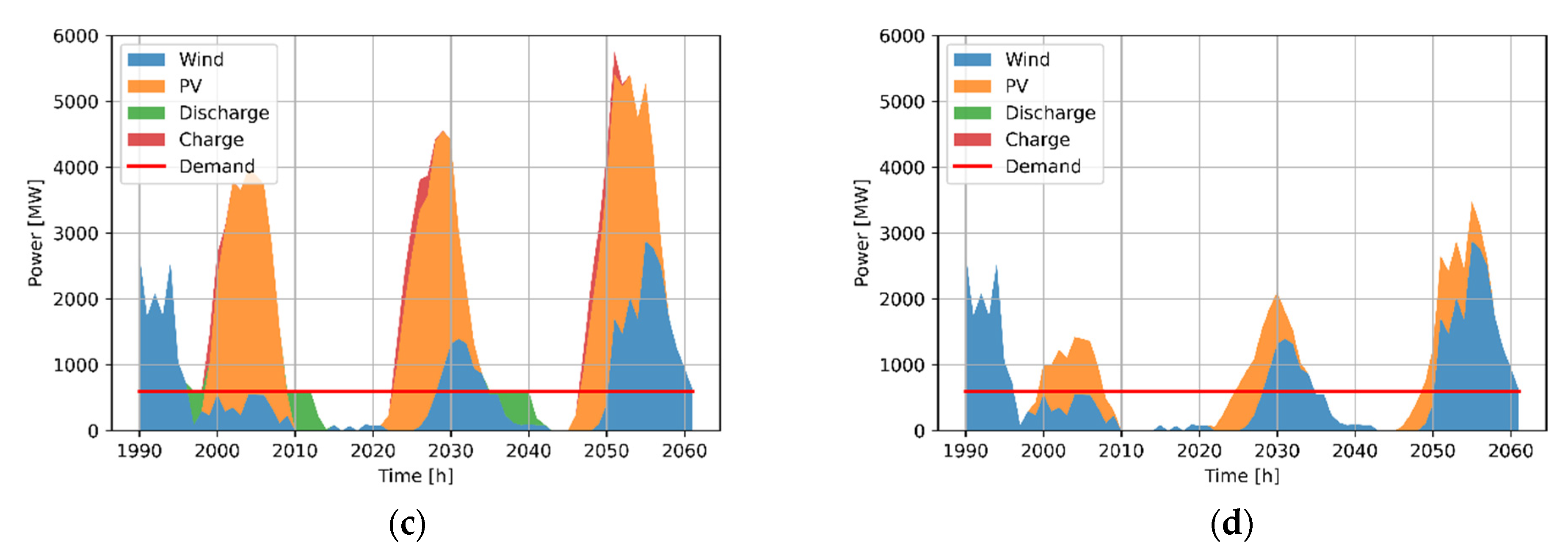

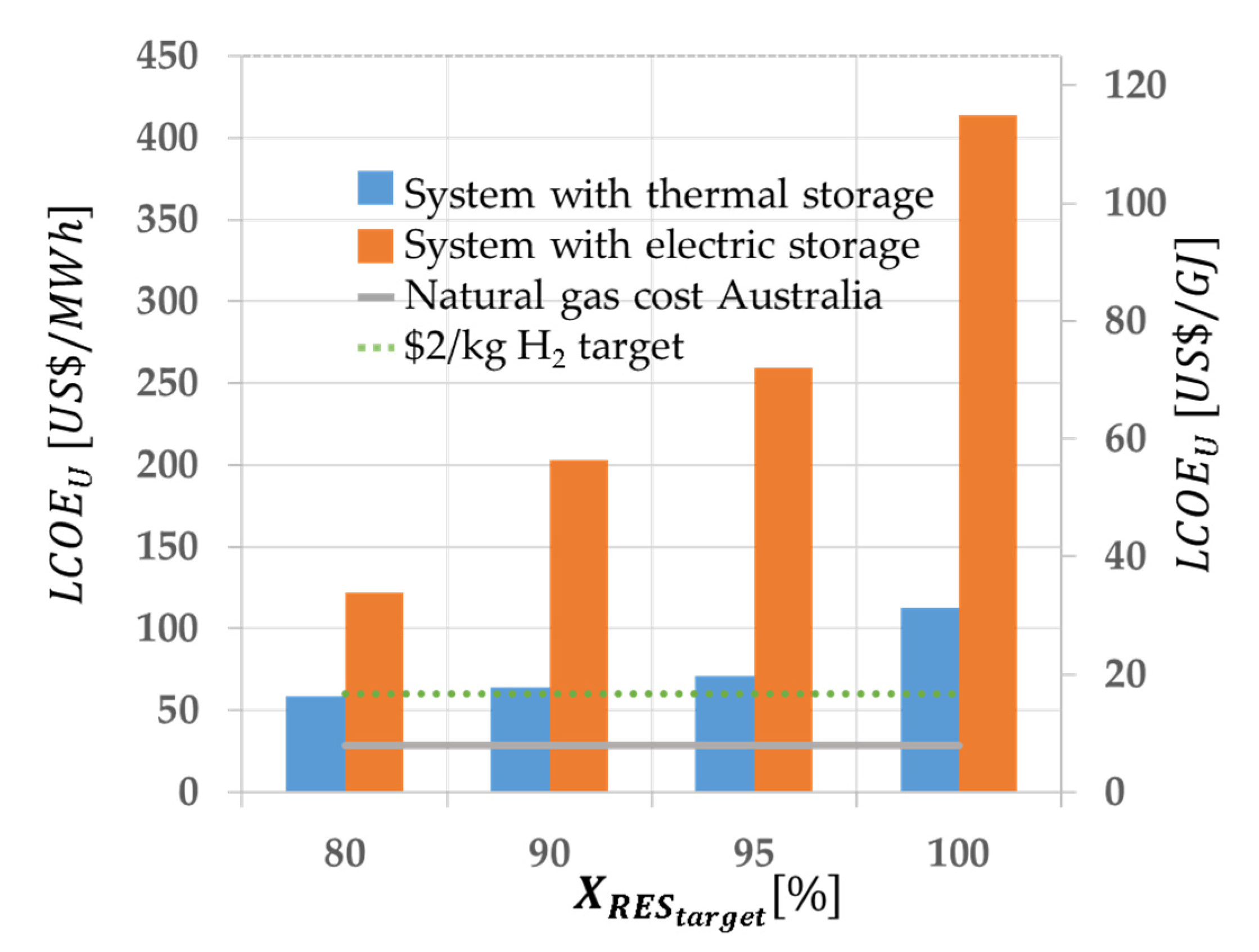
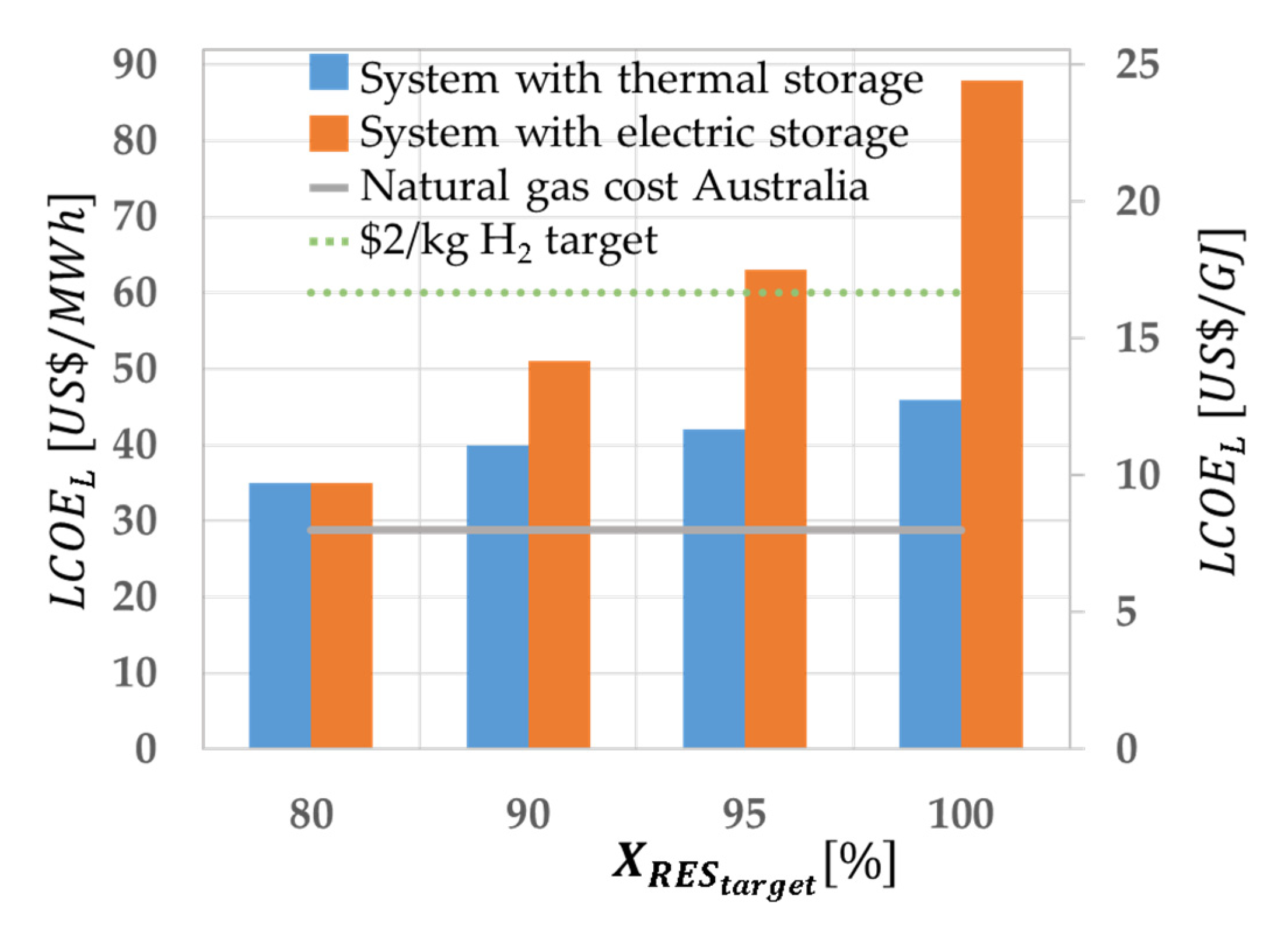
| Greenius | Global Solar/Wind Atlas | JRC-PVGIS | |
|---|---|---|---|
| Annual DNI | 2750 kWh/m2 | 2939 kWh/m2 | NA |
| Annual GHI | 2343 kWh/m2 | 2361 kWh/m2 | 2424 kWh/m2 |
| Specific annual energy output per installed PV peak power | 1897 kWh/kWp | 1983 kWh/kWp | 1821 kWh/kWp |
| Average wind speed | 8 m/s | 8 m/s | NA |
| Wind Turbine Model: Dewind D8.2—2000 kW_IEC_IIA | Wind Park Model | ||||
|---|---|---|---|---|---|
| Rotor diameter | 80 | m | Number of turbines | 50 | - |
| Design power | 2000 | kWe | Design power | 200 | MWe |
| Hub height | 80 | m | Field efficiency | 96 | % |
| Nominal wind speed | 14 | m/s | Measurement height | 5 | m |
| Cut-in speed | 4 | m/s | Auxiliaries service | 3 | % |
| Cut-off speed | 25 | m/s | Annual availability | 98 | % |
| Air density | 1.2 | kg/m3 | Roughness length | 0.1 | m |
| Photovoltaic Module | PV System Model | ||||
|---|---|---|---|---|---|
| Nominal peak power | 250 | Wp | Availability | 99 | % |
| Nominal efficiency | 12.4 | % | Cleanliness | 95 | % |
| Cell type | Poly-Si | - | Shadowing factor | 100 | % |
| Temperature coefficient: Power | −0.5 | %/°C | Total nominal DC peak power | 100 | MWp |
| Temperature coefficient: Voltage | −0.4 | %/°C | Total nominal AC peak power | 96.3 | MWp |
| Temperature coefficient Current | 0.1 | %/°C | Orientation | 180 | ° |
| Tilt | 23 | ° | |||
| Excess dumped/upper bound (island configuration) | Thermal storage | |
| Electric battery storage | ||
| Export possible/lower bound (grid connection) | Thermal storage | |
| Electric battery storage |
| Technology | Capital Expenditure | Operational Costs |
|---|---|---|
| Wind Power | US$ 1400/kWe | US$ 48 kWe/year |
| PV System | US$ 1000/kWe | US$ 13 kWe/year |
| Air heater | US$ 240/kWth | US$ 4.8 per kWth/year |
| Thermal Storage | US$ 40/kWh | US$ 0.8 per kWh/year |
| Electric Storage | US$ 1000/kWh | US$ 10 per kWh/year |
| 80 | 4.9 | 1.2 | 0 | 16365 | 2276 | 13385 |
| 90 | 4.9 | 4.7 | 1.8 | 16365 | 8916 | 20025 |
| 95 | 4.9 | 4.8 | 3.6 | 16365 | 9105 | 20215 |
| 100 | 4.9 | 4.9 | 7.5 | 16365 | 8536 | 19645 |
| Battery | 80 | 2.5 | 1.1 | 0.8 | 8350 | 2087 | 5180 | 6.0 |
| 90 | 2.1 | 1.7 | 3.4 | 7014 | 3225 | 4982 | 11.1 | |
| 95 | 1.9 | 2.5 | 5.0 | 6346 | 4742 | 5832 | 15.0 | |
| 100 | 4 | 4.9 | 7.5 | 13,359 | 9295 | 17,398 | 25.1 | |
| Thermal | 80 | 1.2 | 0.7 | 5.9 | 4008 | 1328 | 80 | 2.8 |
| 90 | 0.5 | 1.9 | 8.1 | 1670 | 3604 | 18 | 3.3 | |
| 95 | 0.1 | 2.7 | 10.9 | 334 | 5122 | 200 | 3.7 | |
| 100 | 0 | 4.4 | 25.0 | 0 | 8347 | 3091 | 6.2 |
| Battery | 80 | 2.5 | 1.1 | 0.8 | 10,436 | 5180 | 34 | 122 | 6.0 |
| 90 | 2.3 | 1.6 | 3.3 | 10,717 | 5461 | 56 | 203 | 11.2 | |
| 95 | 0.9 | 2.5 | 5.0 | 11,088 | 5832 | 72 | 259 | 15.0 | |
| 100 | 4 | 4.9 | 7.5 | 22,654 | 17,398 | 115 | 414 | 25.1 | |
| Thermal | 80 | 1.2 | 0.7 | 5.9 | 5335 | 80 | 16 | 59 | 2.8 |
| 90 | 0.5 | 1.9 | 8.1 | 5274 | 18 | 18 | 64 | 3.3 | |
| 95 | 0.3 | 2.5 | 10.26 | 5744 | 488 | 20 | 71 | 3.8 | |
| 100 | 0 | 4.4 | 25.0 | 7588 | 3091 | 31 | 113 | 6.2 |
| Battery | 80 | 4.9 | 1.2 | 0 | 18,641 | 13,385 | 10 | 35 | 7.6 |
| 90 | 4.9 | 4.8 | 3.3 | 25,471 | 20,215 | 14 | 51 | 14.8 | |
| 95 | 4.9 | 4.9 | 3.6 | 25,660 | 20,404 | 18 | 63 | 18.5 | |
| 100 | 4.9 | 4.9 | 7.5 | 25,660 | 20,404 | 24 | 88 | 26.3 | |
| Thermal | 80 | 4.9 | 1.2 | 0 | 18,641 | 13,385 | 10 | 35 | 7.6 |
| 90 | 4.9 | 0.2 | 5.2 | 16,744 | 11,488 | 11 | 40 | 7.8 | |
| 95 | 4.9 | 0.6 | 8.1 | 17,503 | 12,247 | 12 | 42 | 8.4 | |
| 100 | 4.9 | 2.3 | 12.5 | 20,728 | 15,472 | 13 | 46 | 10.6 |
| Electric Battery Storage | Thermal Storage | ||||||||
|---|---|---|---|---|---|---|---|---|---|
| 80% | 90% | 95% | 100% | 80% | 90% | 95% | 100% | ||
| [US$/MWh] | Upper bound | 122 | 203 | 259 | 414 | 59 | 64 | 71 | 113 |
| [US$/MWh] | Lower bound | 35 * | 51 | 63 | 88 | 35 * | 40 | 42 | 46 |
| 3.5 | 4.0 | 4.1 | 4.7 | 1.7 | 1.6 | 1.7 | 2.5 | ||
Publisher’s Note: MDPI stays neutral with regard to jurisdictional claims in published maps and institutional affiliations. |
© 2022 by the authors. Licensee MDPI, Basel, Switzerland. This article is an open access article distributed under the terms and conditions of the Creative Commons Attribution (CC BY) license (https://creativecommons.org/licenses/by/4.0/).
Share and Cite
Profaiser, A.; Saw, W.; Nathan, G.J.; Ingenhoven, P. Bottom-Up Estimates of the Cost of Supplying High-Temperature Industrial Process Heat from Intermittent Renewable Electricity and Thermal Energy Storage in Australia. Processes 2022, 10, 1070. https://doi.org/10.3390/pr10061070
Profaiser A, Saw W, Nathan GJ, Ingenhoven P. Bottom-Up Estimates of the Cost of Supplying High-Temperature Industrial Process Heat from Intermittent Renewable Electricity and Thermal Energy Storage in Australia. Processes. 2022; 10(6):1070. https://doi.org/10.3390/pr10061070
Chicago/Turabian StyleProfaiser, Andrea, Woei Saw, Graham J. Nathan, and Philip Ingenhoven. 2022. "Bottom-Up Estimates of the Cost of Supplying High-Temperature Industrial Process Heat from Intermittent Renewable Electricity and Thermal Energy Storage in Australia" Processes 10, no. 6: 1070. https://doi.org/10.3390/pr10061070
APA StyleProfaiser, A., Saw, W., Nathan, G. J., & Ingenhoven, P. (2022). Bottom-Up Estimates of the Cost of Supplying High-Temperature Industrial Process Heat from Intermittent Renewable Electricity and Thermal Energy Storage in Australia. Processes, 10(6), 1070. https://doi.org/10.3390/pr10061070






